Related Research Articles

The shilling is a historical coin, and the name of a unit of modern currencies formerly used in the United Kingdom, Australia, New Zealand, other British Commonwealth countries and Ireland, where they were generally equivalent to 12 pence or one-twentieth of a pound before being phased out during the 1960s and 1970s.

The pound was the currency of Australia from 1910 until 14 February 1966, when it was replaced by the Australian dollar. Like other £sd currencies, it was subdivided into 20 shillings, each of 12 pence.
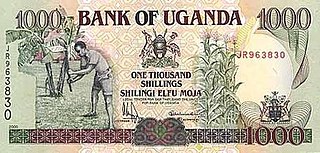
The shilling is the currency of Uganda. Officially divided into cents until 2013, due to substantial inflation the shilling now has no subdivision.

The Somaliland shilling is the official currency of the Republic of Somaliland, an unrecognised sovereign state in the Horn of Africa, recognised internationally as de jure part of Somalia.
The Bermudian dollar is the official currency of the British Overseas Territory of Bermuda. It is subdivided into 100 cents. The Bermudian dollar is not normally traded outside Bermuda, and is pegged to the United States dollar at a one-to-one ratio. Both currencies circulate in Bermuda on an equal basis.

The Jamaican dollar has been the currency of Jamaica since 1969. It is often abbreviated to J$, the J serving to distinguish it from other dollar-denominated currencies. It is divided into 100 cents, although cent denominations are no longer in use as of 2018. Goods and services may still be priced in cents, but cash transactions are now rounded to the nearest dollar.

The Trinidad and Tobago dollar is the currency of Trinidad and Tobago. It is normally abbreviated with the dollar sign $, or alternatively TT$ to distinguish it from other dollar-denominated currencies. It is subdivided into 100 cents. Cents are abbreviated with the cent sign ¢, or TT¢ to distinguish from other currencies that use cents. Its predecessor currencies are the Trinidadian dollar and the Tobagonian dollar.
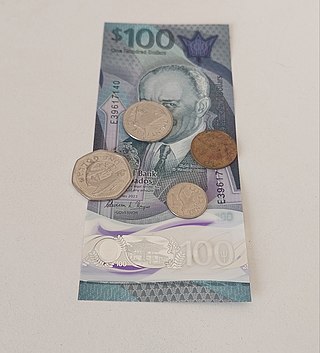
The dollar has been the currency of Barbados since 1935. Globally its currency has the ISO 4217 code BBD, however, unofficially in Barbados the International vehicle registration code BDS is also commonly used, a currency code that is otherwise reserved for Bangladesh outside Barbados. As such the present Barbados dollar has the official ISO 4217 code of BB which matches the [dot] .bb Cc-TLD domain names classification for Barbados under ISO 3166, plus D for dollar in the foreign exchange market. The Barbadian dollar is considered as a currency which can be divided into 100 cents, though the 1 cent coin is in the process of being phased out. In terms of population, Barbados is the third smallest country in the world after Tonga and the Seychelles to have an independent currency and monetary policy.

The Somali shilling is the official currency of Somalia. It is subdivided into 100 senti, cents (English) or centesimi (Italian).

The East African shilling was the sterling unit of account in British-controlled areas of East Africa from 1921 until 1969. It was issued by the East African Currency Board. It is also the proposed name for a common currency that the East African Community plans to introduce.
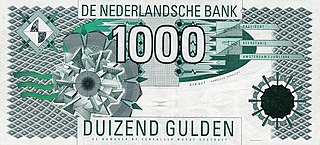
The guilder or florin was the currency of the Netherlands from 1434 until 2002, when it was replaced by the euro.

The pound was the currency of New Zealand from 1840 until 1967, when it was replaced by the New Zealand dollar. Like the pound sterling, it was subdivided into 20 shillings each of 12 pence.
The rupee was the currency of Britain's East African colonies and protectorates between 1906 and 1920. It was divided into 100 cents.
The pound was the currency of the Gambia between 1965 and 1971. Gambia used the British West African pound until it issued its own currency on October 5, 1964. In 1971, the dalasi replaced the pound at a rate of £1 = D5. 1 pound was made up of 20 shillings, each shilling consisting of 12 pence.

The Somalo was the currency of the Trust Territory of Somaliland administered by Italy between 1950 and 1960. The "Somalo" remained officially in use in the newly created Somali Republic until 1962. It was subdivided into 100 centesimi.
The Tuvaluan dollar is one of the currencies of Tuvalu, whose unofficial international currency code is TVD. Tuvalu has never had banknotes of its own, and has been issuing coins since 1976. However, the Tuvaluan dollar is used as a unit of account, and is pegged to the Australian dollar at parity. From 1966 to 1976, Tuvalu officially used the Australian dollar. In 1976, Tuvalu began issuing its own coins, which continue to circulate alongside Australian coins. Tuvalu continues to use Australian banknotes. Tuvaluan coins are not legal tender in Australia. Similar to the Faroese króna's relationship to the Danish krone and the Panamanian balboa's relationship to the United States dollar, the Tuvaluan dollar is not an independent currency, but a variation of the Australian dollar.
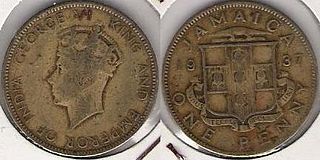
The pound was the official currency of Jamaica between 1840 and 1969. It circulated as a mixture of sterling coinage and locally issued coins and banknotes and was always equal to the pound sterling. The Jamaican pound was also used in the Cayman and Turks and Caicos Islands.
The rupee was the currency of Zanzibar from 1908 to December 31, 1935. It was subdivided into 100 cents.
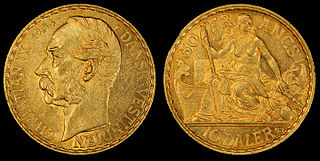
The daler was the currency of the Danish West Indies between 1849 and 1917, and of the United States Virgin Islands between 1917 and 1934.
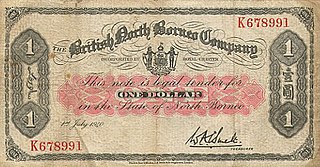
The British North Borneo dollar was the currency of British North Borneo from 1882 to 1953. It was subdivided into 100 cents. The dollar had remained at par with the Straits dollar, the currency of Malaya and Singapore, at the value of one dollar to 2 shillings 4 pence sterling from its introduction until both currencies were replaced by the Malaya and British Borneo dollar in 1953. Both coins and banknotes were issued by the British North Borneo Company.
References
- Global Financial Data currency histories table
- Tables of modern monetary history: Kenya
- Tables of modern monetary history: Tanzania
- Tables of modern monetary history: Uganda
| Preceded by: East African rupee Ratio: at par | Currency of East Africa (Kenya, Tanganyika, Uganda) July 31, 1920 – December 31, 1921 | Succeeded by: East African shilling Ratio: 2 shillings = 1 florin = 2 British shillings |